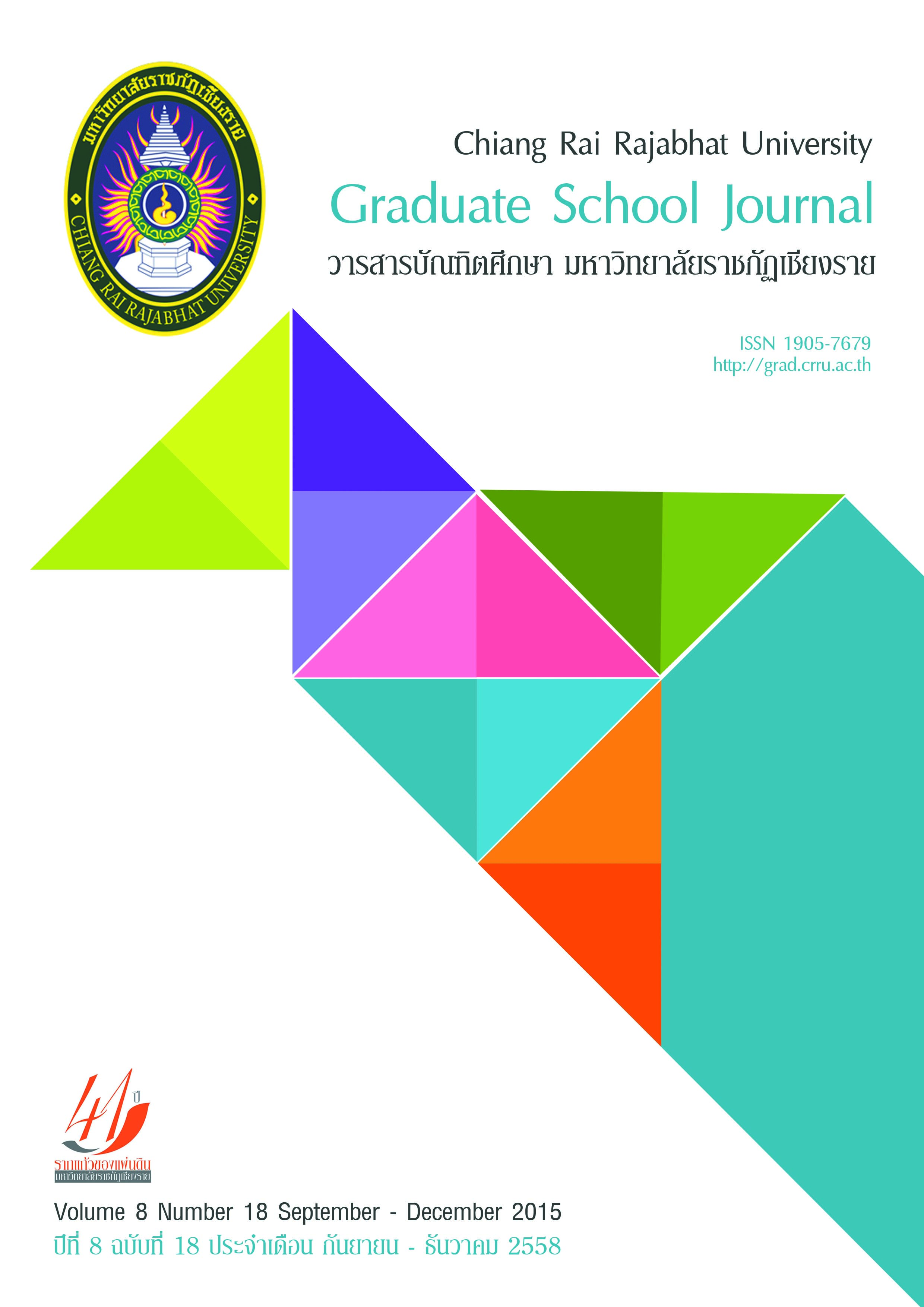องค์ประกอบความสามารถในการใช้เทคโนโลยีในการเรียนรู้ ของนักเรียนระดับชั้นมัธยมศึกษาตอนปลายในจังหวัดพะเยา
Main Article Content
บทคัดย่อ
การศึกษาครั้งนี้มีวัตถุประสงค์ เพื่อศึกษาความสามารถในการใช้เทคโนโลยีในการเรียนรู้ของนักเรียนระดับชั้นมัธยมศึกษา ตอนปลายในจังหวัดพะเยา วิเคราะห์องค์ประกอบเชิงสำรวจความสามารถในการใช้เทคโนโลยีในการเรียนรู้และยืนยันผลการ วิเคราะห์องค์ประกอบเชิงยืนยันความสามารถในการใช้เทคโนโลยีในการเรียนรู้ของนักเรียนระดับชั้นมัธยมศึกษาตอนปลายใน จังหวัดพะเยา กลุ่มตัวอย่างในการศึกษาครั้งนี้ คือ นักเรียนระดับชั้นมัธยมศึกษาตอนปลายในจังหวัดพะเยา ปีการศึกษา 2555 จำนวน 18 โรงเรียน นักเรียนจำนวน 1,386 คน ได้มาจากการสุ่มกลุ่มตัวอย่างแบบแบ่งชั้นภูมิ เครื่องมือที่ใช้ในการศึกษาเป็น แบบสอบถาม วิเคราะห์องค์ประกอบเชิงสำรวจและการวิเคราะห์องค์ประกอบเชิงยืนยันโดยใช้โปรแกรมคอมพิวเตอร์สถิติสำเร็จรูป เพื่อการวิจัยทางสังคมศาสตร์
ผลการศึกษาพบว่า
1. ความสามารถในการใช้เทคโนโลยีในการเรียนรู้ของนักเรียนระดับชั้นมัธยมศึกษาตอนปลายในจังหวัดพะเยามีค่าเฉลี่ย 3.55 เมื่อวิเคราะห์ตัวแปรเป็นรายข้อพบว่าตัวแปรมีค่าเฉลี่ยและส่วนเบี่ยงเบนมาตรฐานใกล้เคียงกัน ตัวแปรที่มีค่าเฉลี่ยสูงสุด คือ ตัวแปรที่ 6 นักเรียนชอบเทคโนโลยี และตัวแปรที่ 7 นักเรียนชอบใช้เทคโนโลยีในการศึกษาค้นคว้า มีค่าเฉลี่ย 4.05 ส่วน ตัวแปรที่มีค่าเฉลี่ยน้อยที่สุด คือตัวแปรที่ 46 นักเรียนหยุดเรียนเมื่อต้องการจะหยุด มีค่าเฉลี่ย 2.86 และตัวแปรที่ค่าเบี่ยงเบน มาตรฐานสูงสุด คือ ตัวแปรที่ 109 ครูพูดเสมอว่านักเรียนต้องใช้สื่อเทคโนโลยีอย่างมีประโยชน์และสร้างสรรค์มีค่าส่วนเบี่ยงเบน มาตรฐาน 3.48 ส่วนตัวแปรที่มีค่าเบี่ยงเบนมาตรฐานน้อยที่สุด คือ ตัวแปรที่ 23 นักเรียนทำให้ปัญหามีข้อสรุปที่มีเหตุผล ตรวจ สอบกับแนวคิดและมาตรฐานที่เกี่ยวข้อง มีค่าส่วนเบี่ยงเบนมาตรฐาน 0.74
2. การวิเคราะห์องค์ประกอบเชิงสำรวจ สามารถอธิบายความแปรปรวนสะสมได้ร้อยละ 54.47 ค่าสถิติ Bartlett’s test of Sphericity มีค่า 79332.189 (Sig < .000) แสดงว่า เมตริกซ์สหสัมพันธ์ไม่เป็นเมตริกซ์เอกลักษณ์ค่าดัชนีไกเซอร์-ไมเยอ ร์-ออลคิน (Kaiser-Meyer-Olkin Measure of Sampling Adequacy) หรือค่า KMO มีค่า .913 แสดงว่าตัวแปรมีความสัมพันธ์ กันเหมาะสมที่จะนำไปวิเคราะห์องค์ประกอบเชิงสำรวจ มีองค์ประกอบที่ชัดเจน 9 องค์ประกอบ ที่มีค่าไอเกนมากกว่า 1.00 และ พิจารณาถึงจำนวนตัวแปรที่ร่วมกันชี้วัดค่าความแปรปรวนของแต่ละองค์ประกอบตั้งแต่ 3 ตัวขึ้นไป และมีน้ำหนักองค์ประกอบ ที่มีค่ามากกว่า 0.30 ขึ้นไป จำนวน 69 ตัวแปร
3. การวิเคราะห์องค์ประกอบเชิงยืนยั จากการปรับโมเดล สามารถวัดระดับความกลมกลืนระหว่างโมเดลกับข้อมูลเชิง ประจักษ์ มีค่าเท่ากับ 22.3 ที่องศาอิสระ (df) มีค่า 16 ค่าความน่าจะเป็น (P) มีค่า 0.133ค่าดัชนีวัดระดับความกลมกลืน (GFI) มีค่า 0.99 ค่าดัชนีวัดระดับความกลมกลืนที่ปรับแก้แล้ว (AGFI) มีค่า 0.98 ค่ารากของค่าเฉลี่ยกำลังสองของเศษเหลือในรูปคะแนน มาตรฐาน (RMR) มีค่า 0.021 และค่ารากของค่าเฉลี่ยกำลังสองของความคลาดเคลื่อนโดยประมาณ (RMSEA) มีค่า 0.024 ซึ่ง สรุปได้ว่า โมเดลองค์ประกอบความสามารถในการใช้เทคโนโลยีในการเรียนรู้ของนักเรียนระดับชั้นมัธยมศึกษาตอนปลายในจังหวัดพะเยา ที่สร้างจากการวิเคราะห์องค์ประกอบเชิงสำรวจมีความเหมาะสมกับข้อมูลเชิงประจักษ์
The Applications of High-School Students’ Technological Competence-Based Components in Their Learning in Phayao Province
The purposes of this study aimed to explore the applications of the high-school students’ technological competence-based components on their learning in Phayao Province, to analyze exploratory components related to applications of the high-school students’ competence-based components on their learning, as well as to approve the analyses of confirmatory components resulted from the applications of the high-school students’ technological competences to effectively managing their learning in Phayao Province. In the academic year 2012, a questionnaire was conducted with 1,386 high-school students out of the eighteen secondary schools in Phayao Province, which were all selected by the stratified random sampling technique. The exploratory and confirmatory data were statistically analyzed through using the Statistical Programmer.
The findings of the study were as follows:
1. The high-school students’ technological competence- based components on their learning in Phayao Province, with its mean of 3.55, were all rated at a higher level. As compared to each aspect, it was stated that the 6th variable on student’s technological preferences, and the 7th variable related to student’s technological preferences on information retrievals, with its mean of 4.05, were mostly observed; otherwise, the 46th variable on student’s lecture- preferred day-offs, with its mean of 2.86, were rated a lowest level. Moreover, the 109th variable on student’s mutual technological applications and creativities, with its standard deviation of 3.48, were mostly observed, meanwhile the 23rd variable related to student’s problematic consensuses and panel discussions, with its standard deviation of 0.74, were rated at a lowest level;
2. In terms of the analyses of exploratory components compared with the accumulated variance with its percent of 54.478, as well as the Bartlett’s test of Sphericity with its mean of 79332.189 and its significant difference of < .000, as well as the Kaiser-Meyer-Olkin Measure of Sampling Adequacy (KMO) of 0.9133, it showed that nine major components with its Eigen values of more than 1.00 were all testified with exploratory components whereas sixty-nine major variables with its mean of more than 0.30 were mostly observed in terms of its variance compared with more than three variables.
3. In terms of the analyses of confirmatory components, it showed that the of 22.3 with its degree of freedom (df) of 16, possibility (P) of 0.133, goodness of fix index (GFI) of 0.99, adjusted goodness of fix index (AGFI) of 0.98, standard root mean square residual (SRMR) of 0.021, and root mean standard expected average (RMSEA) of 0.024 were all found in this adjusted model compared with the empirical data. Overall, the exploratory factor analysis resulted from the adjusted model in relations to the applications of the highschool students’ technological competence-based components to managing their learning in Phayao Province were consistent with the empirical data.
Article Details
บทความที่ได้รับการตีพิมพ์เป็นลิขสิทธิ์ของวารสารมหาวิทยาลัยราชภัฎเชียงราย
ข้อความที่ปรากฏในบทความแต่ละเรื่องในวารสารวิชาการเล่มนี้เป็นความคิดเห็นส่วนตัวของผู้เขียนแต่ละท่านไม่เกี่ยวข้องกับมหาวิทยาลัยราชภัฎเชียงราย และคณาจารย์ท่านอื่นๆในมหาวิทยาลัยฯ แต่อย่างใด ความรับผิดชอบองค์ประกอบทั้งหมดของบทความแต่ละเรื่องเป็นของผู้เขียนแต่ละท่าน หากมีความผิดพลาดใดๆ ผู้เขียนแต่ละท่านจะรับผิดชอบบทความของตนเองแต่ผู้เดียว


